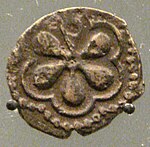Al-Nasir Muhammad
| An-Nasir Muhammad الناصر محمد |
|||||
|---|---|---|---|---|---|

Al-Nasir Muhammad copper fals, 1310-1341. British Museum
|
|||||
|
Sultan of Egypt and Syria (first reign) |
|||||
| Reign | December 1293 - December 1294 | ||||
| Predecessor | Al-Ashraf Khalil | ||||
| Successor | Kitbugha | ||||
| Regent | Kitbugha | ||||
| (second reign) | |||||
| Reign | 16 January 1299 - March 1309 | ||||
| Predecessor | Lajin | ||||
| Successor | Baybars II | ||||
| Regent | Baybars II and Seif ad-Din Salar | ||||
| (third reign) | |||||
| Reign | 5 March 1310 - 7 June 1341 | ||||
| Predecessor | Baybars II | ||||
| Successor | Saif ad-Din Abu-Bakr | ||||
| Born | 16 Muḥarram 684/24 March 1285 Cairo, Mamluk Sultanate |
||||
| Died | 21 Dhū al-Ḥijja 741/7 June 1341 (age 57) | ||||
| Consorts | Qutlughmalik, daughter of Emir Tankiz Al Husami Narjis Ardu Bayad Kuda |
||||
| Issue | Anuk Ahmad Abu Bakr Ismail Sha'ban Ramadan Hajji Kujuk Hasan Salih Husayn |
||||
|
|||||
| House | Qalawuni | ||||
| Dynasty | Bahri | ||||
| Father | Qalawun | ||||
| Mother | Ashlūn bint Shaktāy | ||||
| Full name | |
|---|---|
| Al-Malik an-Nasir Nasir ad-Din Abu'l Ma'ali Muhammad ibn Qalawun |
Al-Malik an-Nasir Nasir ad-Din Muhammad ibn Qalawun (Arabic: الملك الناصر ناصر الدين محمد بن قلاوون), commonly known as an-Nasir Muhammad (Arabic: الناصر محمد), or by his kunya: Abu al-Ma'ali (أبو المعالى) or as Ibn Qalawun (1285–1341) was the ninth Mamluk sultan of Egypt who ruled for three reigns: December 1293–December 1294, 1299–1309, and 1310 until his death in 1341.
An-Nasir Muhammad was born and died in Cairo. He was the youngest son of Sultan Qalawun and the brother of Sultan Al-Ashraf Khalil. He was born in Cairo at Qal'at al-Jabal (Citadel of the Mountain). His mother was of Mongol origin.
Al-Nasir Mohammad married Khawand Toghay, who started as his slave but was freed by him. She gave birth to Prince Anook.
His reign was in three stages, as he was deposed twice during his reign.
After the assassination of al-Ashraf Khalil in December 1293, he was installed as sultan with Zayn-ad-Din Kitbugha as the regent and vice-sultan and Emir Sanjar al-Shuja'i as vizier. As an-Nasir was only 9-years-old, he was a sultan in name only. Kitbugha and al-Shuja'i were the actual rulers of Egypt. The two emirs, Kitbugha, who was of Mongol origin, and al-Shuja'i were rivals and did not get on with each other. al-Shujai, with the support of the Burji Mamluks, planned to arrest Kitbugha and assassinate his emirs but Kitbugha laid siege to the Citadel and the conflict ended with the murder of al-Shuja'i and the removal of the Burjis from the Citadel.
When Emir Hussam ad-Din Lajin, who had fled after the murder of al-Ashraf Khalil, returned to Cairo, the Burji Mamluks, who were known as the al-Mamalik al-Ashrafiyah Khalil (Mamluks of al-Ashraf Khalil) and who were removed from the citadel by Kitbugha, rebelled and went on a rampage in Cairo because Lajin had not been arrested and punished for his involvement in the murder of their benefactor Sultan al-Ashraf Khalil. The Ashrafiyah were defeated and many of them were killed and executed. Lajin convinced Kitbugha to depose an-Nasir Muhammad and install himself as sultan after he warned him that the Ashrafiyah and an-Nasir would seek revenge for the murder of Khalil in which Kitbugha had been involved. Kitbugha deposed an-Nasir Muhammad and installed himself sultan with Lajin as his vice-sultan. An-Nasir, who was by now 10 years old, was removed with his mother to another section in the palace where they stayed until they were sent to Karak thus ending the first reign of an-Nasir Muhammad.
...
Wikipedia
